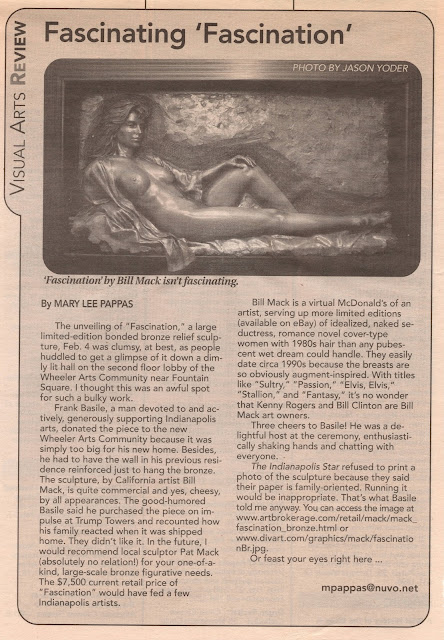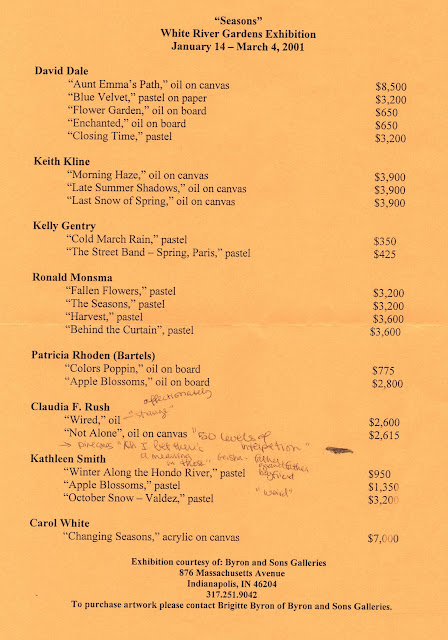An art critique as well as exhibition preview and overview archive spanning from 1999 to 2012 by Mary Lee Pappas, the art critic for the alternative weekly newspaper, NUVO, and visual arts columnist for the daily paper, The Indianapolis Star. Indianapolis, Indiana.
Ad
Wednesday, December 12, 2001
The Photography Gallery - The Stutz Business Center - Dec. 12, 2001 - 3 stars
Seven Stutz artists show their stuff, a confetti finale, at the gallery which has relocated to Mass. Ave. The varied (textile, bronze and painted) art pieces work well together. One artist's work doesn't overwhelm another's as the spacious gallery gives even the largest color splashes of Stutz standards such as Mecklin, Darrell and the many very different and design heavy painted mannequin forms by Brooks equal quality wall time. Technically graceful with overlapping, subtle layers of fabric acting like paint, Rebecca Lyons' fabric art is effective, conceptually intelligent and a pleasure to view. Through Dec. 21, 2001; 317-972-1981. -Mary Lee Pappas
Wednesday, December 05, 2001
Night Vision - Utrillo's Art – Dec. 5, 2001 – 3 1/2 stars
No other art space in the city is as authentically and honestly eclectic - really and truly - as Greg Brown's Utrillo's. "Outsider" art in the paint-by-numbers variety and new to antique frame sales (a must stop shop for starving artists) in addition to Brown's own work (far from naive) are what's found during the daylight hours. After dark, his interchangeable, vaguely Gothic, comforting, stained glass-looking painted panels fill the storefront space ceiling to floor, and are illuminated to create an ethereal holiday display, best viewed from the "X" marked on the sidewalk across the street. Drive by and jump out of your car for a minute to enjoy Brown’s work, which is part of an infinite series joy-filled, humble and somewhat spiritual paintings titled The Kingdom of Heaven is like the Psychological Realm. Through Dec. 29, 2001; 317-684-9883. – Mary Lee Pappas
Holiday One Piece Show – Dean Johnson – Dec. 5, 2001 – 2 stars
This variety show needs more cayenne in its jumbled gumbo. The sculpted cherry wood chair and blanket, "Bull Legged Boy," by Natasha Young was of exceptional quality making the pieces that didn't hit her high notes look tone deaf. Though pieces don't adhere to a theme in the sharp gallery space that could make potato sacks look like fine art, there is an unsettling randomness in the overall display that doesn't enhance the quality or beauty of some individually great pieces. Through Jan. 3, 2002; 317-634-8020. - Mary Lee Pappas
Wednesday, November 21, 2001
Jo Legner - Hot House Gallery - Nov. 21, 2001 - 3 stars
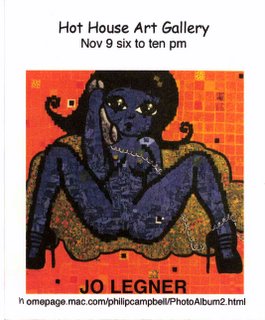
Subtle kink meets collage in Legner's loosely lurid, bold, black-outlined Japanimation girl paper mosaics. Beautiful and delicately printed Japanese, Thai and English papers are chopped up (most in 2-inch blocks) and reassembled to give life to her large-scale, convincingly innocent (and one or two not so innocent) and, dare I say, cute, sexy cartoon girls. The fairy straddling a flower, the blue girl spread-eagled on the phone, the bunny-girl investigating carrots, the bare-breasted kitty-woman and the other girls on revue are all perfectly composed for their square format, as if they were individual animation cells. Hardly a parody, these pieces are wildly lively, with a fresh sense of freedom and fun in art, yet are created with care and accomplishment. Legner has a keen artistic vision to be able to piece together seemingly unlike paper colors and textures and then have the end results create the right balance of depth and space for her caricatured beauties. Through Dec. 31, 2001; 686-0895. - Mary Lee Pappas
Tuesday, November 20, 2001
Why Collect Art? by Mary Lee Pappas - Nov. 20, 2001
NUVO Newsweekly,
November 28 - December 5, 2001
Page 20
Mary Lee Pappas
Art whiners be warned. Hoosiers are buying original art by living artists. Local gallery owners can vouch for what Greg Lucas, owner of G.C. Lucas Gallery in the Meridian-Kessler neighborhood, calls “a very strong art market.” Granted, certain styles of grittier, edgier work are harder to sell, but people are still willing to spend money on art here.
Local art galleries are welcoming, low-pressure places to visit. But Doris V. Hails, curator at Woodburn and Westcott, has reported that guests have asked if there is an admission charge to peruse her gallery space. The general public in Indianapolis has little experience at visiting galleries, so it is not uncommon for gallery owners to receive calls like, “What is the proper attire to wear to an opening?” and, “Are children welcome?”
No admission is charged at galleries. Gallery art openings are not black-tie affairs, so come as you are comfortable, whether that means jeans, suit or whatever. Well-behaved children, accompanied by adults, are absolutely welcome, although Phil Campbell, owner of Hot House Art Gallery, artist and father, advises, “Come with an open mind,” as nudity in art is a time-honored standard.
It is perfectly fine to visit a gallery to browse. Simply walking into a gallery is not a commitment to purchase, so set those checkbook anxieties aside. “There are some people that come in for an art fix,” Hails says.
“It’s a great thing when people come in just to view the art,” David Kadlec, owner of Eye Blink Gallery in Fountain Square, observes. “By picking up on the stories artists are telling they can open up conversations with their family, their kids. They are taking part in the cultural community.”
Nora Campbell, art director at the Domont Studio Gallery near Fletcher Place, agrees. “All galleries want people to feel comfortable. The doors are always open to come in and look and appreciate. We’re just glad people come in,” adding that a gallery’s role should be to educate the public about art.
Art education dialogue is more accessible in a gallery than at a hush-hush museum. Instead of blindly scanning a wall of art in a mausoleum atmosphere, an open conversation can be had at a gallery, and usually with the owner. “I’m here for that!” Hails says.
Greg Lucas has found that people are intimidated by art vocabulary, so he engages and educates his gallery guests about generic art language, like the meaning of painting “loose” versus “tight” and “modern” versus “contemporary.” It is completely acceptable to state that you like a work of art because it’s “neat” or “pretty.” The ability to rattle off historical, period-specific, academic art jargon won’t impress anyone and will not necessarily enhance an emotional response to any artwork. And art is all about emotional response — especially for the virgin buyer.
Art connoisseur, or not, the most important criterion for an art purchase should be to like and be attracted to a piece. Kadlec describes this motivator as “people being drawn to the statement being made by the artist.” It’s OK to want something because it’s beautiful or is reminiscent of a trip to wherever, whenever, too. In truth, the numero uno reason people purchase art is because it reminds the buyer of something and provides an emotional outlet.
Lucas sums it up best: “It’s an emotional thing.” He explains that people are not buying art to match their couch. “The point of a painting is that it should stand out from the sofa.”
A piece of art cannot be judged by its price tag alone. Worthy and desirable art is not indicated by an exorbitant price or an artist’s tombstone. Price usually reflects innumerable can’t-put-your-finger-on factors. For instance, an artist’s work may be priced high because he can command that price in other cities or because she has been producing work for 35 years and shouldn’t sell for less.
A low-priced painting can be of greater artistic quality than a higher priced piece. Price points for high quality, original art run across the board, so everyone can afford something. “I remain convinced that it’s not the dollar amount that sells the work. It’s a position of love,” Kadlec says of art purchases.
Nora Campbell stresses that a customer will “have to love it because they’ll be living with it.”
Buying an original piece of art from a local gallery contributes to local economy and the local arts community. It is a contribution to the financial and professional success of the artist and gallery. Art by working, living artists naturally appreciates over time but can’t be guaranteed — so purchasing for investment is discouraged. The majority of people who purchase art aren’t interested in investment anyway. Kyle Blevins, a photographer who recently showed his work at Eye Blink, says that by purchasing original art “you own your art community. It’s a personal investment.”
Most galleries offer financing. Lucas says, “We work with [buyers] to help them own the painting.” Clients are offered discounts on repeat purchases and are encouraged to acquire art by the same artists. He also sells gift certificates, has painting savings plans and offers discounts on individual pieces if they are available. Some galleries like Kadlec’s have a fixed price policy. “It’s rare that anyone has asked for a discount,” Kadlec says — but don’t be embarrassed to inquire.
“We have to,” Nora Campbell says of financing. “Original art is not a mass market. Most paintings are more than what people can just write a check for.”
Phil Campbell notes that the price range for personal spending on art “is all over the place. The majority spend between $1,200 to $1,500 on average.”
At Woodburn and Westcott, I witnessed an unassuming patron purchase an Indiana landscape by Lynn Thomsen for $2,200. Stanley Woodburn Hails, gallery manager of Woodburn and Westcott, says, “You wouldn’t have a clue what a customer looks like,” observing that customers are as diverse as the artwork itself.
Doris Hails admits that some people are hesitant about purchasing real art for themselves because “It doesn’t seem normal to have real art on their walls.”
Phil Campbell agrees, “They want what’s safe, what their friends have, what blends into the woodwork.” But original art can be more affordable than framing a poster print — and it’s a one-of-a-kind.
A limited edition, prepackaged Thomas Kinkade print-transfer-to- canvas from the mall (one of 3,900 made to simulate a real painting) will cost $640 and up, depending on the size and the edition. An original figurative watercolor work by Phil Campbell, on the other hand, is only $325. A consumer who buys a big-name Kinkade because it feels safe (all the neighbors have one next to their Nancy Noels) isn’t getting a bargain. In 50 years, the piece a local museum (say the Indianapolis Museum of Art or the Indiana State Museum) would consider acquiring in exchange for a tax deduction, or the piece your grandchildren would be happy to inherit, is more likely to be an original that has a sense of history and withstands the test of time. In 20 years, those Kinkades will probably be on sale in Goodwills and Salvation Army shops.
Some artists have inadvertently altered the face of local art history with their unique contributions. The significance of their accomplishments, their styles, techniques and local roots all make a piece of original art valuable.
A buyer who buys based on name alone is an uninformed collector. There are, however, a few notable art personalities who are recommended for your art consumption. Nhat Tran, whose studio is located next to the Midland Antique Mall, is an artist whose lacquer works have been exhibited and acquired by the Smithsonian for their permanent collection. Tran uses an unusual and very toxic ancient lacquer technique to produce work that is influenced by her Asian roots, but inspired by the West. The Hoosier Salon represents the amazing impressionistic oil paintings of Patricia Rhoden Bartles. Bartles’ visions of Southern Indiana landscape have reinvented the familiar Hoosier Group ideals. John Domont is another Indiana landscape artist who recently finished two 15-foot commission pieces for the Riley Children’s Hospital in addition to having two paintings acquired by the Indiana State Museum for their permanent collection. They are but a few artists in Indianapolis who justify Doris Hails’ claim that “We are a wealthy city in terms of the arts.”
Peruse NUVO’s Galleries space in the Calendar for the most recent shows in the city. Scribble down those telephone numbers and call with all your art inquires. Visit and ask more questions. Don’t be discouraged if you are immediately in love with the first artwork you see.
Phil Campbell, David Kadlec, Doris Vlasek Hails, Doris Hails, Ann Leggett, G.C. Lucas Gallery, Greg Lucas, Hot House Art Gallery, Eye Blink Gallery, Nora Campbell, John Domont, Domont Studio Gallery, Indianapolis Museum of Art, Newfields, Nancy Noel, Patricia Rhoden-Bartles, That Tran, Hoosier Group, Indiana State Museum, Kyle Blevins, Lynn Thompsen, Stanley Woodburn Hails, Midland Antique Mall, Hoosier Salon, Riley Children's Hospital
Wednesday, November 14, 2001
Lynn Thomsen - Woodburn and Westcott - Nov. 14, 2001 - 3 1/2 stars
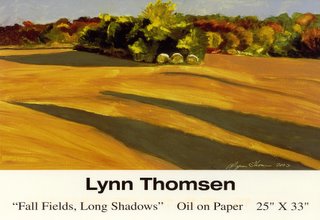
Thompsen's art is about where we are and where we live. Her pastoral, predominantly green paintings aren't just of the typically expected rural Boone County fields and southern country meadows, but of Eagle Creek and the ultra urban woods of Butler University. The sense of depth and definition in theses scenes is outstanding considering the swiftness at which the strokes look smattered, albeit intentionally, on the paper. Her true color farming fields carry an all too familiar feel that anyone who has driven anywhere in Indiana can appreciate. Thomsen is a skilled artist who fearlessly puts paint down, confidant about space and reality. Through Dec. 31, 2001. 916-6062. - Mary Lee Pappas
**********
Lynn Thomsen, July 30, 1957 - January 3, 2008

Thomsen, Lynn,
January 5, 2008
Indianapolis Star
Lynn Thomsen She passed away at 10:45 a.m., January 3, 2008 at the IU Medical Center, Indianapolis. She was born in Lafayette, IN on July 30, 1957, and lived with her parents in Delphi, until her graduation from Delphi Community High School in 1975. She graduated Summa Cum Laude with a B.F.A. from Herron School of Art in Indianapolis. She went on to teach at Marion College, IUPUI, St. Richard's School, and for the past 7 years she chaired and taught in the Art department at Park Tudor School. Lynn was a landscape artist, and concentrated on scenes of rural Indiana. She has works hanging at the IU Medical Center, The Anderson Hospital, Women's Wing, and in the permanent collection of Indiana artists at the Indiana State Museum, along with many private collections. Lynn was the court room artist at the 1992 Mike Tyson Rape Trial where her drawings were aired on Channel 6 News and ESPN. She currently has a 22 piece show at the Mary Anderson Center for the Arts, Loftus House Gallery, 101 St. Francis Dr., Mount St. Francis, IN. The exhibit will run through March 1, 2008. She is survived by her husband, Clifford Hull, her stepson Clifford Jr., her parents Cliff & Jean Thomsen of Delphi, IN, one brother, Eric (wife Carole) of Delphi, one sister, Teresa Holeman (husband John), of Charleston, S.C.; 4 nieces; Amber Cleavenger (husband Kyle) of Colburn, IN, Cassandra Rowley (husband J.T.) and Erienne Thomsen of Terre Haute, IN., Justine Holeman, of Charleston, S.C., as well as 3 great nephews and innumerable wonderful friends and colleagues. A celebration of her life will be held on Monday January 7, 2008 at 4:00 pm at Flanner & Buchanan Funeral Center-Broad Ripple with a gathering starting at 12:00 pm to service time. Persons wishing to express their condolences may do so by recycling. In lieu of flowers, donations can be made to the Coburn Place Safe Haven 604 E. 38th Street Indianapolis, IN 46205.
**********
In Memoriam: Lynn Thomsen
by Barb Shoup Jan 16, 2008
NUVO

When Lynn Thomsen and I traveled through France together in 1994, she carried a packet of blank cards wherever we went and made sketches on them, which she sprayed with fixative and sent home as postcards to family and friends. I was fascinated by what caught her eye. The pattern of stones beneath the running water of a river, the peeled paint of a shutter were as interesting to her, as worthy of her attention as the Eiffel Tower or the Louvre. She made a sketch of me to send to my husband — not at Monet’s Giverny, but in the corner of a straggly garden down the road amidst hollyhocks whose petals were crumbling to dust.
“You were made to set here to give voice to this, your own astonishment,” the writer Annie Dillard said. Lynn was astonished by everything, and spent her whole life spinning her astonishment into marvelous forms, imprinting herself on the world around her. Art and life were the same thing to her.
There she is in the whimsical living space she created, a loft in an old building on 30th Street, with hornets’ nests, still on their branches, hanging from the high ceiling and birds’ nests, rocks, shells, geodes — bits of the earth she collected, wandering. There’s a fabricated steel swing big enough to hold two people that she hung in the middle of the huge room. A gargantuan blackboard she salvaged from an old school and mounted in her kitchen, chalk tray included. A cat stairway with a nifty bridge to a sleeping perch — because every living being was accommodated in her life.
Lynn’s astonishment at being alive shimmers in her paintings hanging on the walls: luminous plowed fields, trees mirrored in summer-calm lakes — the light in them as real as the light pouring in through the huge loft windows.
You can see the fruits of it in the lives of hundreds of students whom she loved and taught, and who adored her, instinctively understanding that she was not only teaching art, but teaching them how to be. Her countless friends knew it when, again and again, she directed our attention to some small thing that made the world crack open in a way we’d never have imagined and, in doing so, lightened our heavy hearts.
Lynn’s time in the world she loved was far too short. But the light she made wherever she went will live among us always.
Kyle Blevins "The Dead Bird Series" - Eye Blink Gallery - Nov. 14, 2001 - 4 stars
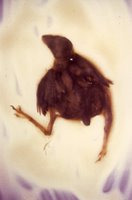
Blevins' large 20-inch-by-24-inch glossy prints taken from a huge Polaroid at Columbia in Chicago are hardly morbid or grotesque, but poignant. One little goldfinch is at rest among brittle, dried roses, the colors of which are dulled and dreamy. They romantically convey a sense of peace. The photos evoke memories of life and loss, giving the show a particularly timely and universal quality. Through Dec. 31, 2001. 636-6363. - Mary Lee Pappas
* The son of a funeral director, Blevins recognized that these discarded lyrical and romantic metaphors for life and soul were sadly and ironically dead and found a deep profundity in the ignored and forgotten, yet still beautiful bird life. He collected some dead birds and encased them in liquid latex like bugs in amber, which were either suspended in sheets of glass or shadow boxed, then photographed.
Wednesday, November 07, 2001
Jennifer Kaye - Harrison Center for the Arts - 3 stars
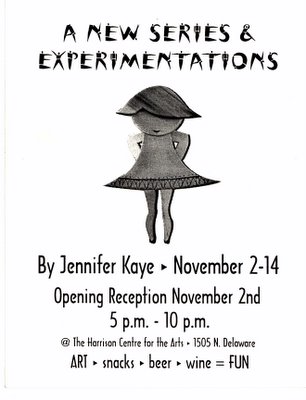
Wood craft and fine art mesh well in Kaye's fanciful women wall sculptures. Her many matrons prance and strike pirouettes in their polka-dot painted dresses and their crescent moon limbs across the gallery walls. These simple in concept sculptures are executed with refinement. Local interior designers would have a hey-day decorating with her stuff. Through Nov. 13, 2001. - Mary Lee Pappas
Thursday, September 27, 2001
Lisa Lynch Habegger - The Bungalow - Sept. 27, 2001 - 3 stars
Habegger paints symmetrical, solid, unadorned vases that project very abstract, harsh shadows. The anthropomorphic donor vessels, sometimes set against little windows with simplistically surreal Mona Lisa landscapes in the distance, look plucked out of a Dali reality - if Dali had been a 15th century Dutch portraitist. This is an analogy, not flattery. "Vessel #6" typifies the verisimilitude and rigid, idealized atmosphere of these glossy oil and acrylic on panel pieces. Perfectly straight horizon lines sharply define the flat, dirt-colored desert foreground that the vessels sit on from the well-coiffed, model train accessory green mountains that cry out, "The hills are alive!" Colors are all true, with no reds in the greens and no greens in the blues. Whatever Habegger is doing, she does well because these pieces are easy to look at and inoffensively pleasing. There is no slight of hand or erroron the artist's part to break the unreal sensation of her landscapes. Through Oct. 4, 2001; 317-251-6028 - Mary Lee Pappas
Thursday, September 20, 2001
"Herron Travels III" - Harrison Centre Gallery - Sept. 20, 2001 - 3 stars
A nice mix of mostly mediocre work from Herron students hangs well in the gallery as testament to recent art education-enhancing travels abroad. The nicest of the nice is a wispy little oil sketch on panel, "The Source," by Christine Blizzard. Priced at a mere $150, it's a bargain-basement price for a painterly prize. A cup bearing a red cross emblem, made in two obvious swift strokes leaving a jagged bristle brush edge, sits upon a counter defined by strong, single sweeps of muddied light blue and yellow-singed grey shadows. Objects on the counter are drawn as murky brown, thin outlines - their color resembling the residue that collects at the bottom of a painter's cup of mineral spirits. Space is defined in concise lines made
with few strokes and with a minimal and dim palette. An obvious scholar of the color wheel, Joseph Sikora's three "La Bois D'Amour Rouge" pieces are, landscapes in black, orange, periwinkle, pinks and reds, swiftly and precisely dappled where the landscape illusion requires it, a green line down a red tree trunk for shadow. Shannon McClane's "The Horse Trainer" is another skillful mentionable. Photos, installation, ceramic sculpture and paintings make up this show that's not really exciting, but not bland either. Through Sept. 26, 2001. 317-920-2494. -Mary Lee Pappas
with few strokes and with a minimal and dim palette. An obvious scholar of the color wheel, Joseph Sikora's three "La Bois D'Amour Rouge" pieces are, landscapes in black, orange, periwinkle, pinks and reds, swiftly and precisely dappled where the landscape illusion requires it, a green line down a red tree trunk for shadow. Shannon McClane's "The Horse Trainer" is another skillful mentionable. Photos, installation, ceramic sculpture and paintings make up this show that's not really exciting, but not bland either. Through Sept. 26, 2001. 317-920-2494. -Mary Lee Pappas
Thursday, September 13, 2001
"White Light" - Herron Gallery - Sept. 13, 2001 - 4 stars
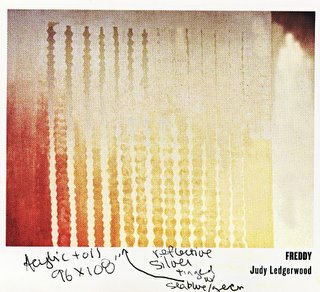
White Light is divine. It accomplishes what it sets out to do, which is to demonsrate the idea of white light as spiritual pure awareness and as an art image itself when light usually only effects the artistic final product. The appropriately named curator, Barry Blinderman, expresses the collective work best in the exhibition brochure. He states, "Light is the oldest and most pervasive visual correlate for attainment and inspiration." All notions of white light (aura, technology and otherworldly) are explored in the works presented. Natural white light is embodied in an untitled photorealistic painting by Jack Goldstein of lightening; while hot solar white light is produced by stepping an a pedal that ignites a blinding 50 light bulb installation by Gregory Green. Two 20-inch-by-20-inch paintings by Christian Garnett resemble eletric currents emitting blue hues -
blue is usually mixed with red/yellow to create electric bulb white light found in the likes of all, arguably uninspirational, color TVs. Two paintings by Susie Rosmarin, one striped and one plaid, mesh multiple spectral colors, generating far-out altered consciousnesslike white light speckles when you close your eyes after viewng. One hundred and twenty prisms, lit by the basic gallery track lighting, rotate slowly producing gentle, bubbling, ghostlike shadows of psychic white light on the gallery walls. Attending this radiantly inspired (pun intended) exhibition, perfectly suited for the Herron Gallery, will enlighten your art consciousness. Through Sept. 29, 2001; 317-920-2420, -Mary Lee Pappas
Phil Campbell "Him and Her" - Hot House Gallery - Sept. 13, 2001 - 3 stars
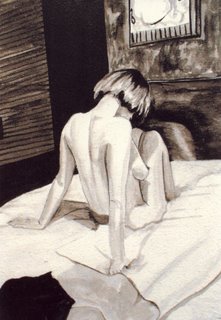
Campbell's latest work is probably his personal best. A bold light blue wll, demonstrating his shrewd curatorial competency, is a backdrop for 20 intimate 5-inch-by-7-inch nude black and white watercolor portraits of him and girlfriend-muse Jo. A triptych of her inspirational image carries the same rich blue hue. Some images are derived and distorted from digital photos, though they appear to be true to life. A graceful arm branches from an indefinable body and a nude fetal positioned seff-portrait is subtly and paradoxically missing Campbell's head. The clever exclusions are delicate and almost subliminal. The levels of comfort and ease with the paint application are apparent when you investigate the all-in-a-row wall of perfectly aligned tiny nudes. The richness of gray tone is parallel to the softer, more comfortable brushstrokes while the heavier, tighter lines equate to the more severe black/white contrast, The overall treatment is, by and large,dexterous and pretty impressive. Through Oct. 16, 2001; 317-686-0895. -Mary Lee Pappas
"Big White Idea" Mark Sawrie- 4 Star Gallery - Sept. 13, 2001 - 1 1/2 stars
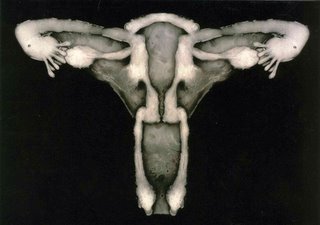
Sawrie uses digital photo techniques to enhance and manipulate his inkjet prints on canvas. The black canvas backgrounds have a soft velvet depth and seem carefully painted. These pieces are executed with practiced, perverted perfection and technical polish. The images (cynical reality meets potentially noxious internal land) are not obviously pleasing, but their disturbing energy is quite overt. They are seemingly absent of provocation and purpose. "Mad Bunny," a Bugs Bunnyish, cartoon-looking, white pigment-based (which means the artists own semen in this case), is a bore. This art is out-of-date if the intention is shock value. All images unemotionally emerge (red and white tones) from a deep void of space with a high contrast of lights and darks. Visit his website at www.moralunderwear.com to view more of his work. Closed Sept. 1, 2001. 317-636-6382. - Mary Lee Pappas
Thursday, August 16, 2001
"Sea Key" Matt Berg - Indianapolis Museum of Art - Aug. 16, 2001 - 1 star
"Sea Key," a sculpture by Matt Berg on display in the third floor of the IMA is just a little too close to the Modigliani for my tastes. The IMA has offered Berg as their current artistic talent in a monthly rotation of the finest contemporary Indiana art. This flavor of the month scrap steel and kiln formed glass piece is boring and kind of phallic. it is girder assemblage meets large-scale oven baked blue drug store craft glass. A rusty patinaed steel beam is a sculpted base for what looks like a large keyhole encased in the same rusty steel. Berg should stick to his large-scale, readily identifiable pieces that are not as design challenged. His artist statement that accompanies the piece is completely convoluted and, as an art history professor of mine in college used to say, "cosmic." Is "Sea Key" supposed to be a conceptual puzzle, or is Berg trying to make his art something it's not? His 10-ton "Bear" created for Galyans in Minneapolis is a very common image yet is wonderfully executed. The very cool brushed stainless steel Broad Ripple Village Neighborhood kiosk at College Ave. and the canal is another of his commissions, utilizing the BRNA's house row logo, to top off his construction competency. Berg is capable of more than what is displayed at the IMA. Unlike most, at least he can say he's exhibited at the IMA now. Through Sept. 2. 317-923-1331.
Thursday, August 09, 2001
Delbecq Sisters - City-County Building - Aug. 9, 2001
Whoa est moi. The devil speaks French and I know this to be true on such a sultry afternoon in the sun-savaged Circle City. My quest to clip the Delbecq duo was fruitless. On the advice of self-assurede city employee found on the other end of my Ameritech tightrope line at the City-County Building, I speed-walked through the downtown's sweaty fog air, my shirt clinging to my shoulder blades. Yes, I called the number listed in NUVO's calendar, for art voyeurs like me to call and inquire about the whereabouts of this mysterious show. In all, I made seven phone calls to three different numbers (requested the information desk twice) and spoke to nine City-County Building employees about the exhibition location. I waited 15 minutes for three different elevators (this is typical adn expected), nothing short of an amusement park ride (I enjoyed the elevator hopping), to take me to the 28th floor where I had been told the exhibit of Delbecq photos was located(seven employees didn't know what I was talking about, two directed me to the 28th floor). I found myself on the observation level among a tourism and state trinket exhibit that the cultural tourism division of our city should spend some time modernizing. What a view! What potential! And how embarrassing that children take field trips to this locale. it wouldn't take $10 million to clean it up. From this vantage, our city, on this unfathomably non-ozone day, was clouded in an ethereal nimbus of overcast conditions. I couldn't find the photos despite my a la Indiana Jones meets Sherlock Holmes investigative style. I intend to go back to the observation level and get a full tour from the lovely older gentleman who oversees that floor. - Mary Lee Pappas
"I See Rhythm" Michelle Wood - Indiana Historical Society - Aug. 9, 2001 - 3 stars
Various forms of African-American music are interpreted in the acrylic works by Wood. All of the pieces on display are originals from her book, I See Rhythm. "Jazz Women" is a piece achieved by collaging blue monochromatic action vignettes of portraits of ladies of jazz like Sarah Vaughan, together in one painting. African masked musicians carry a brilliant primary range of color as they sit among these female greats. The masked faces are a motif in many of her storytelling pieces, with unmasked faces sometimes taking on a tribal facial structure. Quick-drawn strokes of wavering, solid-colored stripes mix as they are cast across the paper canvases, creating genuinely inspired energy and adding to the atmosphere of the pieces. The paint is not pushed or overworked but is layered and easily, comfortably applied. "Ragtime" is perhaps the most sophisticated of the paintings by Wood, on exhibit with its simple flat blocks of solid color and patterns. These works effectively capture the soul of each musical style represented with a traditional African tribal aesthetic reflecting the musical derivation. Through September 3, 2001. 317-232-1882. - Mary Lee Pappas
"Apron Strings: Ties to the Past" - Indiana Historical Society - Aug. 9, 2001 - 2 stars

One hundred aprons should demonstrate the shifting work roles of women and men over the century. Aprons traditionally have been tools of women's labor and consequently women's history, which is often overlooked - as it is in this exhibit. The aesthetic range of the apron collection is great, from ruffle-trimmed organdy and gathered tulle numbers of the to Aunt Bee bibbed styles. They hang too clustered together like campy flags of kitchen coats of arms. The collection reflects fashionable trends and some leisurely church bazaar creativity in the mid-century while overlooking most of the rest of the century (only a few examples from the early part of the 20th century are present) and is not representative of all female lifestyles. The opening exhibit script states, " Aprons are more than kitsch," and suggests ceremony and knuckle-bloody hard work, but does nothing to elaborate on how the apron, as a utilitarian protective garment, was an essential tool to the wife and unpaid domestic laborer. Kitsch is pushed in the collection and in the design of the small exhibition with its clumsy wire arched garden borders, suggesting a mythical happy whimsy. The few exhibit scripts slip sideways (you could crick your neck) in the clothespins that too cleverly hold them to the apron display forms. Women's history is represented with a much more discerning eye in other displays in the Exhibitions Gallery at the IHS. Through December 2, 2001. 317-232-1882. - Mary Lee Pappas
Thursday, August 02, 2001
"Dresden Expressions of Paul Putzki and Caroline Harrison" - The President Benjamin Harrison Home - Aug. 2, 2001 - 3 stars
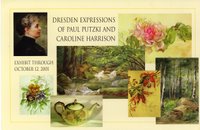
Putzki was a talented watercolorist with a school in Indianapolis were he taught the conspicuous Victorian ladies of leisure the fine art of the era - watercolor and china painting. Women, like the former First Lady Caroline Harrison, lead this fashionable Arts and Crafts hobby of the wealthy on millionaire row. True to Victorian form, Putzki and Harrison's paintings of floral blooms and sparrows are romantically realistic and accurately detailed though not quite the work of one with naturalist's sensibilities like another Victorian, Edith Wharton. Putzki followed Harrison to the White House so that she could continue her painting studies of seemingly stock suspended floral bouquets that typified the genre. Of particular beauty was a delicate and translucent image of orchids that grew in the White House conservatory. When the history of this prim epoch is explored in the Harrison home (a tour is a must to see the exhibit) alongside the wispy lifelike Valentine Day card appropriate pink cabbage rose compositions, the notable artistic talents of Harrison are vividly more apparent. Realistic nimble swabs of color, perfectly applied, effortlessly piece together idealized segments of a proper garden. Blossoms are bona fide in these floral illustrations. Through October 12, 2001. 317-631-1888. - Mary Lee Pappas
Thursday, July 26, 2001
"The Female Persona" Jack Hartigan and Michelle Pemberton - Easter Conservation Services - July 26, 2001 - 2 1/2 stars
Pemberton's "Mother's Little Helper" series, cramped in the gilding and frame restoration dream haven, is hysterical. The 1950's Betty Crocker housewife ideal is parodied in these staged stark black and white shots with high camp props and a modern look. A model, cigarette dangling from her lip, in one shot looks like a haggard moping mess ready to get gooped up for the prom - she also looks as if she's about to bust with laughter at this scenario she's in. Lucky Strikes are tucked into the huge lace-banded nylon panties of a bored Valium-popping model primping for a big night she's obviously somewhat chagrined about. Add the McCall's, prissy wallpaper, train cases and rollers and you've got a charming mythical mockery of 1950's dress-up. The "Seasons" series is soft with tea-stained tones. The overlapping dreamy images of a bouquet-headed beauty look like architectural stone embellishments. Hartigan's photos of centerfolds defaced on the wall of a downtown building, are really graceful, but boring sociological surveys. The textured, spoiled remnants of bombshell babe bedroom shots simply appear as simplistic abstract indiscernible swaps in these large pieces well juxtaposed with Pemberton's work. Through July 27, 2001. 317-507-4701. - Mary Lee Pappas
Casey Cronin and Craig McCormick - Efroymson Gallery at the Harrison Center for the Arts* - July 26, 2001 - 3 1/2 stars

Abstract expressionism and post modernism through photography is brilliantly achieved in McCormick's work. His truly innovative images are shot through cardboard masks, and then further manipulated in the darkroom into subtle cubist renderings. Broken images of urban landscapes, sublimely colored, represent brief periods of time instead of singular split seconds typically seen in photos. Crises in his landscapes erupts, evolving in much the same way modernism did in painting. Reality is torn apart to create an illusion of the image (and the cars and things within the images) and of deep space. Technically, Cronin's work is pristine. Straightforward black and white untitled shots (mix and matchable) from European travels are artistically journalistic and rich with tone variance and a mausoleum silence. They are lonely and intimately bland. "The Laocoon Group," a full-round revolutionary Hellenistic sculpture at the Vatican Museum, is ironically photographed with some sculpture imagery negated from the cropped composition. The celebrated sculpture is spliced into a 2D isolated study. The range of grey tone beautifully defines the agony and realism of the ancient piece. Unfortunately, photo locations were not given and the architectural and sculptural subjects photographed were not named. The photos were dizzyingly displayed. They weren't hung in a coherent fashion and lost their impact split apart. Through August 31, 2001. 317-951-9610.- Mary Lee Pappas
*The Efroymson Gallery is currently the Harrison Center for the Arts Gallery at the Harrison Center for the Arts.
Saturday, July 21, 2001
Frank Glover - Durwyn Smedley's - July 21, 2001 - 3 stars
Closed July 4.
The "Window series," four acrylic on paper energetic astracts by local jazz clarinet great Frank Glover, hang clumsily by clear plastic pushpins in a little corner under two distracting shelves and above some antique knick knacks. Local galleries should be vying to represent this multitalented artist. His work complements and is a colorful and quiet einb-~diment of his music. The influence of his friend, local master Lois Templeton, obvious. Their art style, smooth suriz~ces ai)d colors, is strikingly alike. Cool golden and dirty blue hues are scratched with black charcoal into unintelligible scribble script. The improvisational motions evoke a feeling of quietioie de vivre and soul. This venue is not appropriate for such beautiful work. -Mary Lee Pappas
Connie Zeigler resources Indianapolis historic my Indiana home polis center monthly
Thursday, July 19, 2001
J. David Smith - Munce Art Center - July 19, 2001 - 3 stars

Smith, associate dean of development for the Indiana School of Medicine, takes quality black and white photographs. His artist's statement says that he is inspired by "the ever changing forms and arrangements" of nature which are dissected
artistically by his camera. Local artists take note: This novice wrote a kick-butt, eloquent, well-written and understandable artist's statement. The series of photos on exhibit were all snapped during one walk in Zionsville after a memorably wicked snowstorm in 2000 - the cold miser undoubtedly being Smith's muse. The grandeur of neglected, tiny, fleeting beauty in nature takes center stage in tight compositions that make Mother Nature a Dada disciple. Ice and compacted fallen snow create natural artistic abstractions in "Ice Crystal," "Spider Ice" and "Holy Wall." There is nothing experimental or out of the ordinary with Smith's approach or technique. If I had to guess, I'd say he shot these with a trusty old Pentax K 1000. All of the shots are sharp, frozen, and perfectly exposed with studious exactitude - so much so that the f-stops and shutter speeds for each image could probably surmised as well. It is the care and honesty with which he captures his observations that make his photographs memorable. Through July 28, 2001. 317-873-6862. - Mary Lee Pappas
"Homecoming" Chip Henderson - J.Martin Gallery - July 19, 2001- 3 1/2 stars

Henderson throws narrative art out the window while bulldozing function for form in these mostly large monotone, smooth abstract, atmospheric works. They are musings of mood ripe with Zen and void of visual aversions. Far from being desolate, these subltely striped works evoke contemplative stillness with candlelight translucence. At a glance, the work of Rothko comes to mind, then vanishes upon inspection. These works are delicate. Sheer, careful rows of thinned oil make the canvases appear to be vellum. The dark crimson colors of the painting, "400 Miles," for instance, are formed and manipulated in a series of glassy layers that envelope each other like memories and shadows of our subconscious. The transparency of the paint is pushed and challenged by the infinate density of deep tones. Involuntary meditative participation is bound to occur while viewing these subliminal landscapes. Japanese paper and wax are the vehicles for earth-hued pigment in several pieces including "Hairshirt," the signature piece of the show. Through July 31, 2001; 317-916-2874. - Mary Lee Pappas
Thursday, July 12, 2001
"Sports Heroes - Two Views" James Fiorentino and Elizabeth Yorgen - National Museum of Art and Sport - July 12, 2001 - 2 stars

Thirteen true-to-life head and shoulders sports portraits by the mega accomplished James Fiorentino (23 years old) leave little to the imagination unless you are a student of watercolor. Executed deftly in watercolor, they are amazingly photo realistic and beyond perfect technically. You can see every hair on Cal Ripkin Jr.ís arm. Skin tones are rich and real, proportions are so anatomically faultless that it's no wonder Fiorentino was admitted into the New York Society of Illustrators at the tender age of 19. Images from the 1999 Topps Heritage Baseball Card series he created are on view also. In a big-time contrast are "Temple Games," four mixed media sculpture/conceptual works by Elizabeth Yorgen. Oozing glue gun goo, they comically portray basketball, hockey, baseball and football stars as "idolized in a very similar manner to the way that athletes were idolized in ancient Greece," an artists statement reads. It then makes a parallel to the Temple of Zeus in Olympia where these said athletes are were actually lapiths and the centaurs. Each piece has three humbly painted panels of athletes paired off in physical struggles (tackles and dribbles) flanked by four crude sets of wood colonnades. Could these athletes blasphemously be playing in the bastardized pronaos? Like friezes of the Classical Severe style, the scenes are dramatic, compact, and simple. A paint by numbers primary color scheme prevails as does a coloring book composition. Colors stay inside the lines with model plane precision. The pediments carry modern arena imagery flanked by 3D playing utensils: hockey puck, toy basketball hoop, you get the idea, etc. Through August 12, 2001. 317-274-3627. - Mary Lee Pappas
"Three Women Coming of Age" Patrica Rhoden Bartels, Caroline M. Mecklin, Maureen O'Hara - Hoosier Salon - July 12, 2001 - 4 stars
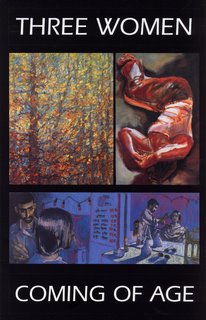
Patricia Rhoden (Bartels), Caroline M. Mecklin and Maureen O'Hara Pesta are three accomplished phenom female Indiana artists. Great impasto strokes of sunshine-enhanced color tease and delight the optic nerve in Rhoden-Bartels' impressionistic Indiana landscapes. The groundless compositions immerse you in dreamy, vibrant, fresh air moments full of wind and lively light. You fly through her distinctive paintings. Her work redefines Indiana art history and is nothing short of spectacular. Mecklin's prolific portraits of her beautiful daughter Libby are seductively silent and utterly feminine. Demure female forms are defined by their confident placidity - they are as much about the splendor of the female body as they are about female assurance within that body. Sweeps and streaks of sporadic and calculated colors combine to create contemporary pseudo odalisques from untraditional perspectives. Pesta's work is very poised. Her approach is less distorted and without the realistic excess or untrue vantages. Quiescent scenes are set and stories told through the precision in her exacting pastel lines. Through July 28, 2001. www.hoosiersalon.org. 317-253-5340. - Mary Lee Pappas
Christina Roberts and Lisa Pelo-McNiece - Art in Hand Gallery - July 12, 2001 -
Closed June 30, Christina Roberts' stained glass work was nowhere to be found. Pelo-McNiece's mouth-blown glasswork was at the gallery, as publicized, and radiantly diverse while consistent in its technical excellence. Two lavender and blue iridescent pieces, dabbled with grassy green flecks, sat perfectly in the window of the c.0-op gallery, their twists and shapes looking sculpted from clay. Most intriguing was a piece that was streaked with deep cherry red and formed with thin copper wire. It had the appearance of a heart with a molten 1,.va volcano top starting to erupi. Liberal use of color powder in her glass created delicate fibrous, granular and ribbed texture patterns. Four individual petite sphere vases glowed-with solid lerhon yellow. - Mary Lee Pappas
Bam Miller - Indianapolis Artsgarden - July 12, 2001 -
Bam Miller's black pen dravvings on flimsy, stark white paper, mattec and covered in what looked like saran wrap taped together on the back, could have used a littleTLC. I readily recognized th illustrative black squiggle line portrait of drummer Jack Gilfay. 'Jimmy Goes to Mai-ket,' of Jimmy Coe, and "Four Other Brothers" were the best drawings in thebunch but that's not saying much. The pieces were stff, flat, fundamental and none. pressive, Jost in their poor presentation. Considering our city recently introduced a $10 million arts initiative, I would expect extra oomph in the level of professionalism demonstrated within the Artsgarden. The AG should have done something to a sist, improve and enhance the presentation of Miller's illustrative work. Do we want to represent the arts in Indianapolis in Such a dismissive way to the throngs of visitors traipsing through the mall? Indianapolis is all aboutjazz in July, so Miller a ac- tion portraits ofiazz musicians are absolutely apropos foe the season. But what'sthe point ~ the show is executed without care? Through July 16; 631-3301. -Mary Lee Pappas
Thursday, June 28, 2001
Cindy Wingo - White River Gardens - June 28, 2001 - 2 stars
Wingo's large, splashy acrylic paintings look as though they were executed with hesitation in her first one-woman show. There is a certain naivete in the way she puts paint (out of the tube?) to her 48-inches-by-48-inches canvases. Quality-wise, the work is unbalanced, though there is a great sense of color and shape. "Guitar" was particularly striking and crossed from the decorative to the painterly with blocks of flat, unfinished color slapped together. "Grand Piano" achieved maturity in its composition and demonstrated freedom in style. Several paintings featured scapegoat techniques: letting paint dribble heavily for no intended effect and scratching through the layers to draw something in. Overall, these works were pleasing and cheery to look at, but fell short otherwise. A predominantly white untitled piece appeared as if it had been pulled off by painting over an old piece she didn't like. Some labels about influences should have been reserved for an artist's statement. Wingo's nifty signature was consistently in the lower right-hand corner of the paintings with one exception: It fell vertically in the top right corner of one canvas making the piece look like it had been hung wrong. Through July 1, 2001; (317) 630-2001 - Mary Lee Pappas
Amy Falstrom - Woodburn and Westcott - June 28, 2001 - 4 stars

Falstrom's work evokes a meditative peace bemused with fantasy. Earthy, golden yellows trickle in layers over simple, analytical, animated brushstrokes. Cross-hatched, teal blues form a muddied, fertile earth ripe with June blooming flowers in "Silent Meeting." Transparent, filmy paint gradations reveal sketched petals of individual blossoms peering from the somber, sparse ground above which two bricklike feet stand - or float? A clay-toned, still waterscape, "Floating Stones," is suggestive of Monet's nympheas murals, but careful and atmospherically faery-touched. A small-scale diptych, "Little Mountains Sant Angelo," achieves depth and realism with masterful half-inch wide strokes - every brush bristle leaving a tale-telling testament to the artist's intentional yellow, green, blue and purple mountain landscape. Falstrom's warm oil paintings are illuminated with yellow hues, evoking a comfortable serenity and a spiritual tranquility. The soft gallery lighting compliments the calm mood of the work. The "Tangle" series of solitary, abstract, tangled, pseudo-organic masses breathe a life of their own. Falstrom's oil paintings, graphite and charcoal drawings are sublimely delightful. Her etchings are superb. Through July 7, 2001; (317) 916-6062. - Mary Lee Pappas
Thursday, June 21, 2001
William Austin Rent - College Ave. Library - June 12, 2001 - 3 stars
Rent, a Shortridge and Herron School of Art graduate, is a talented portrait painter creating crisp African-American-themed images steeped with religious overtones. His pieces are elegant and conservative much in the same vein as the new library currently displaying his work. Grace and sweetness prevail in these provincial, pretty portraits. Idealized subjects lack individual personality with straightforward, full-face poses. They are proud and expressionless - part folksy, part fundamentally formal with urban austerity. Personalities are suggested with symbols and visual clues. Features are smoothed out and sharply defined with very intentional and calculated brushstrokes. Colors are strictly true to life, though the environments of distant backgrounds are sometimes heavenly, misty and imagined. Despite, or perhaps because of, perfectionist painting tendencies, some of Rent's subjects have an off-sense of proportion. His style and technique are unquestionably his own. Through June 30, 2001; (317) 269-1732. - Mary Lee Pappas
VSA Arts of Indiana Group Show - The Bungalow - June 21, 2001 - 3 stars
Freedom and joy in the self-expression experience is evident in the furious finger marks in the clay art made by VSA program participants. My immediate reaction: VSA participants must be very at ease with their teachers because of the abandon and uninhibited independence demonstrated in their art. They feel it and create it. The Bungalow's eclectic, sleek and whimsical store environment befits the spirited show. The clustered clay masks, bowls and small people figures are, however, arranged too tightly together. An arm-locked, sitting, headless, clay people trio made with happy abandon gets lost alongside the throngs of other imaginative small figures. Of particular beauty was a hazy purple landscape executed on a small swatch (10-inches-by-10-inches) of untreated canvas; a blue structure sits on an impulsively-imagined orange-touched green foreground, flat against a lavender sky. This artist understands color. Another piece we'll call "bust of a white kitty" was very impressive as were the clay life-size, and proportionately correct masks. Nurturing self-expression with technique is freely balanced in this show. www.vsai.org. Through June 27, 2001; (317) 253-5028. - Mary Lee Pappas
Thursday, June 14, 2001
Marc Jacobson - Indianapolis Museum of Art - June 14, 2001 - 3 stars
Jacobson, a Herron associate professor, creates stock urban landscapes on paper using gesso and pastel. Some ooze jazz, while others catch a nasty funk. Fortunately, a light and fiery jazz number of the steam plant on West Street (I think) will greet you as you exit the elevators onto the third floor of the IMA. Jacobson's work ordinarily looks as though it was produced using a recipe for proportion and depth of field with a dash of color instinctively thrown in. This single piece depicting urban industrial Indianapolis was splashed with soft blues and pinks to create a chalky, furious, foggy, mundane, familiar moment in an appeasing fashion. A nasty, ugly, polluting machine aesthetically radiates with Jacobson's magical, artistic interpretation. Cool tones and smooth flowing impromptu black lines from the turn of his wrists are delicate, but ever-present. If beauty is in the eye of the beholder, teh Jacobson must be high on life. Through July 1, 2001; 317-923-1331. - Mary Lee Pappas
Justin Cooper - The Monon Coffee Company - June 14, 2001- 4 stars
Fourteen works from a 22-piece series depicting Mayan gods of thunder and rain, maize and the merchant are the latest creations from Justin Cooper. The square and diamond-textured acrylic paintings are hung together, as if they were one large piece, along the coffee shop wall. Cooper's signature subject - soft and stoic, fluid, nude women - strike kneeling, lounging and standing poses suggesting bas-relief plaques from Chiapas or Copan, while still retaining his very distinctive modern look. Random Mayan numeral symbology surrounds the blue (thunder and rain), red (maize), and grey (merchant) women and compliments Cooper's elemental patterned style, creating a fantasy world with a new cosmology. Layers of paint build up the surfaces in small strokes over rich gold underpainting, illuminating the pieces and giving them a depth that glows and shimmers under the low light of the Monon. Through June 30, 2001; 317-255-0510. - Mary Lee Pappas
"2001 Herron Alumni Show" Herron School of Art - June 14, 2001 - 2 stars
The Herron Alumni Association's second annual alumni show showcased a hodgepodge of alumni art, making one question the juror's sensibilities. Unlike the first alumni show, this second incarnation was juried (to veto macrame?) and featured Herron grads from 1943 to 2000. Miraculously, Jack Monninger Jr.'s "Adrift," a poor man's seascape mightmare of crap glommed onto canvas, managed to find its way into the show. Kelly Spangler Mallaby's "Flight," or as the label read, "Filight," was nothing more than handmade white paper goop delicately dripped with green color and pink iridescent party confetti. In contrast, wispy, wispy painted chunks of flesh and shadow made Teruko Schutte's "Figure S" a beautiful standout and a show-saver. Depth and movement made by sweeping, curving vut lines and cool color tones created soft but strong images in tow wonderful woodcuts by Judy Leiviska. Pat Cotton's traditionally Impressionistic "Witness" was easily the most refined piece in teh show. Five flattened figgures became fields of green and white offset by layers of undercoating. The illusion of depth is decoratively precise. June 6-13; 317-920-2420. - Mary Lee Pappas
Thursday, May 31, 2001
"The Human Form Divine" Antonio Criscimagna - John Domont Gallery - May 31, 2001 - 4 stars
 Antonio Criscimagna's debut consists of figurative works. Criscimagna is a creator, rather than painter. Adrenalin and instinct make these unplanned paintings about basic human intimacy and companionship very effective, some more than others.
Antonio Criscimagna's debut consists of figurative works. Criscimagna is a creator, rather than painter. Adrenalin and instinct make these unplanned paintings about basic human intimacy and companionship very effective, some more than others. He produces large, untitled paintings (most in the range of 60-inches-by-42-inches) in a hunter-gatherer vein, foraging for paint tubes in his boiler room studio cave. Thick layers of black acrylic paint frame stark grey and white nude human forms. The simple effect is eerie and calm.
Criscimagna doesn't use models, and so his figures are gutteral and take on earthy forms. Soft lines, abstract proportions, and featureless oval heads all recall a rhythmic, organic, Old Stone Age sophistication, yet elegantly convey contemporary beauty and man/woman/earth unity. The 2000 A.D. angular bodies look chiseled from stone, vaguely reminiscent of Cycladic marble idols c. 2000 B.C. Two biblically themed pieces push his human abstractions to obvious Picasso proportions.
Overlapping shapes energetically engulf each other to perfectly portray Eve emerging from Adam's rib. Distorted lines create the readily recognizable story in an effective modern icon manner.
Through June 30, 2001; (317) 685-9634.
NUVO Newsweekly, May 31 - June 7, 2001
Page 23
Mary Lee Pappas
"Remembering the Ladies: The Early Years of the Indianapolis Retirement Home" - May 31, 2001 - 1 star
The Indianapolis Retirement Home is a very lovely facility that has played an important and unique historical role in our community. Founded in 1867 as the Home for Friendless Women by two Civil War nurses, the home rescued women destitute, widowed adnd some "fallen" after the war. The hom's name has been modified many times in the last 134 years as the home's role distinctivly evolved from originally assisting the transient to its current function as a charming retirement community.
"Remembering the Ladies," an exhibit by IUPUI museum methods students, unfortunately only weakly brushes (and chops) the surface of this altruistic and generous organization that has remained philanthropically bighearted. Regardless, it is a viable history lesson about a remarkable institution. Rich with its own utilitarian antique finery - portraits of the founders, aged bronze plaques and gorgeous furnishings - the home is a natural, spontaneous history lesson in itself. The student work is a diminutive and mildly interesting accent to the already significant space.
For more information about he Indianapolis Retirement Home located at 17th adn Capitol, visit www.indianapolishistory.org, www.indyretirement.org. Through summer 2001; (317) 924-5839. - Mary Lee Pappas
NUVO Newsweekly, May 31- June 7, 2001
Page 23
Mary Lee Pappas
Friday, April 27, 2001
April Show - April 27, 2001
This is the program from The April Show, April 27, 2001
David Hittle, Harry Bloome, Zara Stephens, Thomas Curtis, Jeanette Tibbs, William McKenna, Berry Connell, Jerome Neal, The April Show, Painter, artist, Indianapolis, Naive, outsider
Thursday, April 19, 2001
Sunsets and sunrises - 77th Hoosier Salon Annual Exibition at the Indiana State Museum - April 14, 2001
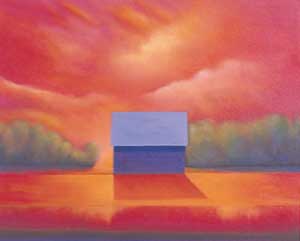
Sunsets and sunrises
Pictured: ‘Serenity’ by John Domont, one of his two paintings that will reside in the Indiana State Museum.
The Hoosier Salon stepped out of the doldrums and into the 21st century with its 77th annual exhibition of Salon artists at the Indiana State Museum. The paintings of kitties, doggies and uninspired Indiana landscapes normally found in this show were still present, but carried an eclectic and acceptable charm when shown alongside their new, dynamic counterparts.
Illia Raha's "When I Was a Child," an abstract oil of fluid, radiating gold and purple, dreamlike hues, virtually exploded off the wall — especially when juxtaposed with the subtle foliage of its painted neighbors. "A Story of Stones," by Sam Sartorius, was another wonderful large-scale abstract with a subdued earth palette.
Patricia Rhoden-Bartles’ "Visions Upward" takes the typical Indiana landscape in a new direction — literally upward. The view/composition is unusual. You peer through bare, golden-orange-touched branches into a robin's egg blue sky. Her brushstrokes are furious and inspired.
John Domont's farm landscapes, "Serenity" and "Contentment," radiate with an ethereal heat unique to Indiana sunsets and sunrises. A familiar red barn is blue in shadow against the glow of a hot red twilight. This stylistic break from the Hoosier Salon norm still reflects Indiana’s sense of place.
The diversity of the Hoosier Salon exhibition is traceable to Ginger Bievenour, the Hoosier Salon's executive director of three years, and a renewed board of directors. Artist recruitment has been pushed and varied aesthetics have been encouraged under this new leadership. "I love abstracts," Bievenour said in discussing the current Salon show. "I was truly euphoric when pieces started coming in."
This show solidifies the fruitful collaboration between the Indiana State Museum and the Hoosier Salon. Both entities are anxiously looking toward the future of art education and heritage in Indiana. Proof in point: Domont's two atypical Hoosier Salon works were purchased for the Indiana State Museum's fine art collection by Douglas L. Tillman, a Hoosier Salon vice president, and will be displayed prominently in the museum’s future 50,000-square-foot Permanent Gallery. Caroline M. Mecklin's figurative oil, "Sleeping Man," and Angel C. Mercado's "Morning at the Light House" were also purchased by the Indiana State Museum Foundation from the show for the Indiana State Museum's permanent fine arts collection.
"We want a more comprehensive grouping of Indiana artists," Jim May, fine arts curator, said of the Indiana State Museum's fine arts collection. The quasi-Impressionistic Hoosier Group replicas thought of as the traditional meat-and-potatoes of Indiana art are not an accurate representation of art produced here since 1940. "We are making every effort to cover those years," May said.
May became curator in 1993 and shortly thereafter something wonderful happened at the Indiana State Museum: The paintings along the staircase finally rotated. And now, the rest of the 20th century in Indiana fine art is being investigated and displayed. A 10,000- to 15,000-square-foot gallery in the new facility will survey Indiana's art history in addition to the 50,000-square-foot Permanent Gallery. Attention potential art donors: Pieces by Mary Beth Eddelson and John Chamberlain are desired.
The efforts of Bievenour and May certainly will continue to move Indiana art forward. As Bievenour said, "The courage of an artist’s convictions to do new work must be applauded and encouraged."
Select works from the 77th Hoosier Salon Annual Exhibition will be featured in a statewide traveling tour. Call the Salon for details at 253-5340.
mpappas@nuvo.net
NUVO Newsweekly, April 19-26, 2001
Mary Lee Pappas
Hoosier Salon, John Domont, Indiana State Museum, Jim May, Illia Raha, Sam Sartorius, Patricia Rhoden-Bartles, Douglass Tillman, Ginger Bievenour, Hoosier Salon Annual Exhibition, Caroline Mecklin, Angel C. Mercado, Mary Beth Eddelson, John Chamberlain, landscapes, paintings, art, artwork, museum, Dane Love, abstract paintings, abstract art, 77th Hoosier Salon Annual Exhibition
Thursday, April 12, 2001
Allotropy Trois
Primary Colours, a local arts organization, will present their third benefit art exhibition, Allotropy Trois, Friday, April 13, 5-10 p.m., and Saturday, April 14, 3-9 p.m., at the newly renovated Harrison Center for the Arts at 1505 N. Delaware St. You can eat ribs and drink beer compliments of Rock Bottom Brewery and indulge in the crazy revelry that will be going down at this artsy engagement.
It's your chance to sneak peak at the rehabbed church reinvented into beautiful artists studios and performance spaces. You can be seen, be cool and contribute to local arts for a measly $5 admission. Proceeds from admission and art sales benefit AYS (formally At Your School Child Services, Inc.), an after school arts suppler program that holds three-week intensive art camps called Reach for the Stars.
Twenty-seven local artist will fill 8,000 square feet of the Harrison Centre with their creations available for you to acquire and beautify your habitat. Mingle while Mpozi merry-makes by spinning dub Reggae. Blend in with the scene while blues duo Los Daddios delights with melancholy mandolins. Incidents of martial arts dance madness (Karate Kid meets Electric Boogaloo?) will occur with the group Capoerira. Imagine, in slow motion, aromatic karate chops with a break dancing edge accompanied by sluggish drum grooves - that's the innovative Capoerira. The contemporary dance company Sussurus will also be performing the same night.
AYS will display work by their talented staff as well as provide a glimpse into their summer camp world. You can register your first through fifth grader for the AYS camp at Allotropy Trois also. The camp will be held at Broad Ripple High School and the Harrison Centre for the Arts in two sessions spanning June 18-July 6. Camp fee is $330. Call (317) 283-3817 to register for camp or get more camp information. Call (317) 916-2874 for more Allotropy information.
NUVO Newsweekly, April 12-19, 2001
Mary Lee Pappas
Thursday, February 22, 2001
"Fascinating Fascination" Bill Mack - Wheeler Arts Community - Feb. 4, 2001
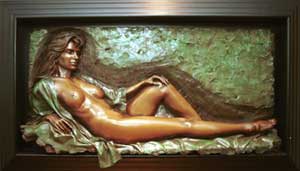
Fascinating "Fascination"
The unveiling of “Fascination,” a large limited-edition bonded bronze relief sculpture, Feb. 4 was clumsy, at best, as people huddled to get a glimpse of it down a dimly lit hall on the second floor lobby of the Wheeler Arts Community near Fountain Square. I thought this was an awful spot for such a bulky work.
Frank Basile, a man devoted to and actively, generously supporting Indianapolis arts, donated the piece to the new Wheeler Arts Community because it was simply too big for his new home. Besides, he had to have the wall in his previous residence reinforced just to hang the bronze.
The sculpture, by California artist Bill Mack, is quite commercial and yes, cheesy, by all appearances. The good-humored Basile said he purchased the piece on impulse at Trump Towers and recounted how his family reacted when it was shipped home. They didn’t like it. In the future, I would recommend local sculptor Pat Mack (absolutely no relation!) for your one-of-a-kind, large-scale bronze figurative needs. The $7,500 current retail price of “Fascination” would have fed a few Indianapolis artists.
Bill Mack is a virtual McDonald’s of an artist, serving up more limited editions (available on eBay) of idealized, naked seductress, romance novel cover-type women with 1980s hair than any pubescent wet dream could handle. They easily date circa 1990s because the breasts are so obviously augment-inspired. With titles like “Sultry,” “Passion,” “Elvis, Elvis,” “Stallion,” and “Fantasy,” it’s no wonder that Kenny Rogers and Bill Clinton are Bill Mack art owners.
Three cheers to Basile! He was a delightful host at the ceremony, enthusiastically shaking hands and chatting with everyone.
The Indianapolis Star refused to print a photo of the sculpture because they said their paper is family-oriented. Running it would be inappropriate. That’s what Basile told me anyway. You can access the image at www.artbrokerage.com/retail/mack/mack_fascination_bronze.html or www.divart.com/graphics/mack/fascinationBr.jpg.
Or feast your eyes right here ...
mpappas@nuvo.net
Thursday, February 01, 2001
Expelled From the Gardens - White River Gardens - Feb. 1, 2001
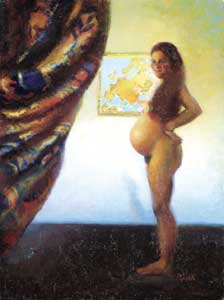
On a sunny Thursday afternoon, I sat on a bench and observed visitors (all aged 50 plus) chattering about the art. Most were fascinated by Claudia’s unconventional work. A painting called “Wired” depicting a serene young woman wearing a chicken wire cage contraption around her head was affectionately termed “strange” by one fascinated visitor. “Not Alone” depicts the same woman sitting at a dressing table cluttered with mementos. Intrigued, one man said, “I bet there are 50 levels of interpretation to this piece.” I was thrilled to see local art displayed so successfully at this bustling civic venue.
But when I called Claudia to relay the active interest Gardens audiences had taken in her work, I learned that a painting of hers was censored from the show for its nude content by White River Gardens administrators. Curious, I went straight to Byron and Sons Galleries to view it.
This was it? This was expelled from the Gardens? I expected something explicit, obscene, vulgar. This little painting of a nude pregnant woman seemed modest and subdued compared to more traditional nudes — for instance, “Glow of Gold, Gleam of Pearl” by William McGregor Paxton, on view in the American Gallery at the Indianapolis Museum of Art.
I wondered: Who is responsible for this censorious insecurity and for what reason? How unsophisticated do White River Gardens administrators believe their audience to be? As lovely as the White River Gardens exhibit is, it’s a burning reminder of how artistically unprogressive Indianapolis is — and not by the fault of its artists.
The White River Gardens exhibit, Seasons, will continue through March 4; 1200 W. Washington St. (630-2001). Byron and Sons Galleries is located at 876 Massachusetts Ave. (916-2465).
mpappas@nuvo.net
Subscribe to:
Comments (Atom)







